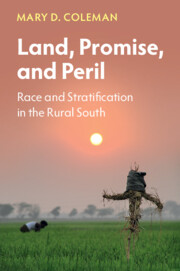Book contents
- Land, Promise, and Peril
- Cambridge Studies in Stratification Economics: Economics and Social Identity
- Land, Promise, and Peril
- Copyright page
- Contents
- Figures
- Tables
- Preface
- Acknowledgments
- Part I The Family in an Intemperate Community, State, and Nation
- Part II Family Interiority and Economic Mobility Pathways
- Part III Pathways toward Upward Economic Mobility
- 13 Beyond Caste in Higher Education
- 14 The War on Poverty and the Poor in Sunflower
- 15 What the Research Tells Us
- 16 Insights and a Valedictory
- Epilogue
- Select Bibliography
- Index
15 - What the Research Tells Us
from Part III - Pathways toward Upward Economic Mobility
Published online by Cambridge University Press: 15 April 2023
- Land, Promise, and Peril
- Cambridge Studies in Stratification Economics: Economics and Social Identity
- Land, Promise, and Peril
- Copyright page
- Contents
- Figures
- Tables
- Preface
- Acknowledgments
- Part I The Family in an Intemperate Community, State, and Nation
- Part II Family Interiority and Economic Mobility Pathways
- Part III Pathways toward Upward Economic Mobility
- 13 Beyond Caste in Higher Education
- 14 The War on Poverty and the Poor in Sunflower
- 15 What the Research Tells Us
- 16 Insights and a Valedictory
- Epilogue
- Select Bibliography
- Index
Summary
Social and behavioral scientists and humanities scholars, especially historians and economists, have offered a context for understanding what it means to be down and out in America across time and place. Economists have analyzed the determinants of economic mobility and which factors create varying rates of sustainable economic progress. For example, Raj Chetty has posited that social capital, segregation, inequality, school quality, and family structure are predictors of economic mobility. Apparent, too, in Chetty’s work, is economic mobility’s bidirectional trajectory, both upward and downward. This bidirectionality means that some in the middle class have been able to rise from the lower class, and some have fallen from the high-income quintiles to the middle class and below it. Economists such as William Darity and Darrick Hamilton, economic stratification economists, have shown that income inequality and wealth inequality are not the same, and hence, securing income equality alone will not reduce wealth inequalities.
Keywords
- Type
- Chapter
- Information
- Land, Promise, and PerilRace and Stratification in the Rural South, pp. 324 - 366Publisher: Cambridge University PressPrint publication year: 2023

